
Potted Palm Trees: The Ultimate Guide to Choosing, Growing, and Caring for Indoor Palms
Imagine adding a touch of tropical beauty to your home with lush, vibrant potted palm trees 
In this comprehensive guide, we’ll walk you through everything you need to know about potted palm trees—from selecting the best varieties for indoor spaces to providing the proper care for long-lasting growth. Whether you’re a seasoned plant parent or a beginner, you’ll find practical tips that will help your potted palm trees thrive. Let’s dive in and turn your space into a green oasis!
Table of Contents
ToggleWhat Are Potted Palm Trees? 
Potted palm trees are indoor or outdoor plants grown in containers, offering an easy way to add a tropical, stylish touch to any space. Unlike palm trees planted directly in the ground, potted palms can be moved around and placed in different areas of your home, garden, or patio. These palms are perfect for those who want the beauty of tropical foliage without the commitment of ground planting.
Whether you’re looking to brighten up your living room, create an inviting outdoor oasis, or simply enjoy the benefits of palm trees in a portable form, potted palms offer flexibility and low-maintenance care.
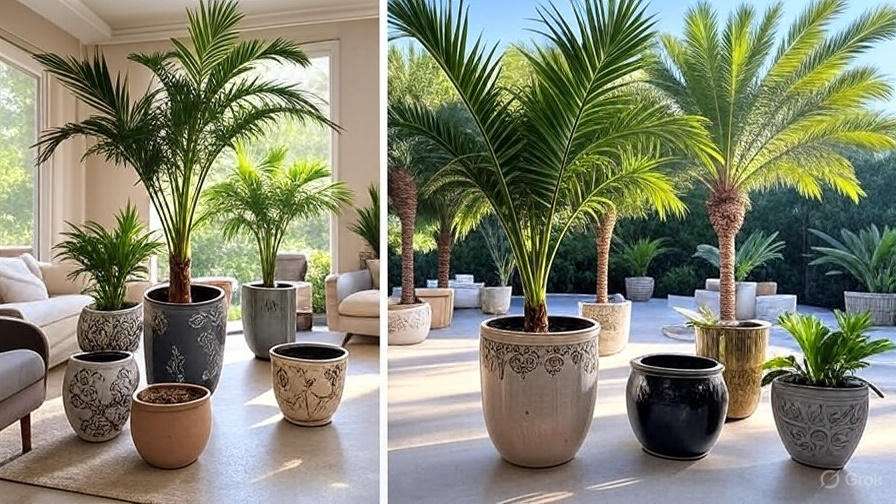
Why Choose Potted Palm Trees?
- Flexibility: Potted palms can be moved to suit the season, sunlight changes, or your design preferences. You can place them indoors for a pop of greenery in the colder months and move them outside to enjoy the sun during warmer seasons.
- Space-Saving: For small gardens, patios, or apartments, potted palms allow you to enjoy tropical plants without taking up too much space.
- Variety: There are various types of palm trees that thrive in pots, from the small, compact Areca Palm to the grand Kentia Palm, so you can choose one that suits your space and aesthetic.
- Ease of Care: Most potted palms are easy to care for and require minimal maintenance. With the right conditions, they can thrive for years, making them perfect for beginners or busy gardeners.
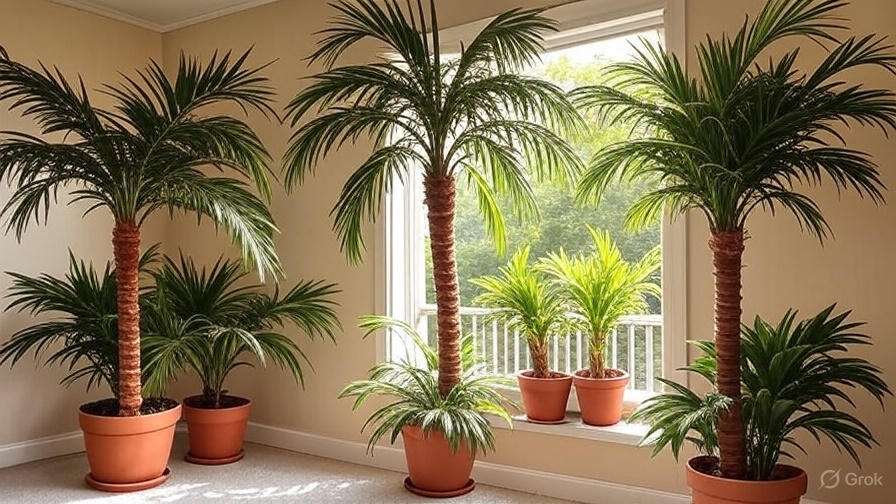
How to Choose the Right Potted Palm Tree
- Consider Your Space: Smaller palms are great for indoor spaces or smaller outdoor areas, while larger ones are best for bigger gardens or patios.
- Light Requirements: Some palms, like the Parlor Palm, thrive in low light, making them great for indoor spaces. Others, like the Sago Palm, need plenty of direct sunlight.
- Climate Considerations: If you’re planning to keep your palm outside, choose varieties that are suited to your climate zone. For cooler areas, opt for hardier types like the Needle Palm.

Best Potted Palm Tree Varieties for Indoor Spaces 
When it comes to bringing a touch of tropical charm indoors, potted palm trees are an excellent choice. They’re easy to care for, add vibrant greenery to any room, and can thrive in a variety of indoor conditions. But which palm trees are the best for your home? Here’s a list of the top potted palm tree varieties that will thrive in your indoor spaces with a little love and care.
1. Areca Palm (Dypsis lutescens) 
The Areca Palm, also known as the butterfly palm, is one of the most popular indoor palms. Its feathery, arching fronds create a lush, tropical look. It’s great for beginners because it’s low-maintenance, requiring only indirect sunlight and moderate watering. Keep the soil slightly moist, but avoid letting it sit in water to prevent root rot.
Best for: Bright indoor spaces with indirect light. Perfect for living rooms and offices.
2. Parlor Palm (Chamaedorea elegans) 
The Parlor Palm is a classic indoor palm known for its attractive, glossy leaves. It’s incredibly adaptable and can thrive in low light, making it ideal for darker corners of your home. This palm is also forgiving when it comes to watering—just let the top of the soil dry out before watering again.
Best for: Low light conditions and small spaces. A fantastic choice for apartments.
3. Kentia Palm (Howea forsteriana) 
If you’re looking for an elegant palm that grows slowly and is easy to maintain, the Kentia Palm is a great option. Its tall, graceful fronds make it a stunning statement piece. This palm tolerates low light and dry air, making it an excellent choice for indoor spaces with fluctuating temperatures.
Best for: Low to medium light. Ideal for living rooms, hallways, and offices.
4. Bamboo Palm (Chamaedorea seifrizii) 
The Bamboo Palm, also known as the reed palm, is a popular indoor palm due to its attractive, tall appearance and ability to purify the air. It grows well in low to medium light and doesn’t require too much maintenance. Regular watering and a bit of humidity will keep it thriving.
Best for: Rooms with moderate light and those looking to improve air quality.
5. Majestic Palm (Ravenea rivularis) 
Majestic Palms are known for their elegant, feathery fronds that add a bold touch to any room. They prefer bright, indirect light and need a bit more attention when it comes to watering—keep the soil evenly moist, especially during warmer months. This palm makes a stunning centerpiece in large indoor spaces.
Best for: Bright indoor spaces. A perfect addition to spacious living rooms or foyers.
6. Ponytail Palm (Beaucarnea recurvata) 
Despite its name, the Ponytail Palm is technically a succulent, not a true palm. Its unique look, with long, flowing fronds resembling a ponytail, makes it a fun and stylish addition to any indoor space. It thrives in bright light and is extremely drought-tolerant, so it’s perfect for beginners who may forget to water occasionally.
Best for: Bright, sunny spots in your home. Great for desks, windowsills, and corners.
7. Sago Palm (Cycas revoluta) 
Though not a true palm, the Sago Palm has a striking appearance with its thick trunk and spiky, feather-like leaves. It prefers bright, indirect light and well-drained soil. This palm is slow-growing but can live for many years, making it a long-term investment for your home.
Best for: Sunny rooms and as a decorative centerpiece.

Care Tips for Indoor Palm Trees 
No matter which palm you choose, proper care is key to ensuring they thrive. Here are some general tips for growing healthy potted palm trees indoors:
- Light: Most palms prefer indirect light. Too much direct sunlight can scorch their leaves.
- Watering: Keep the soil evenly moist, but not waterlogged. Allow the top 1–2 inches of soil to dry out before watering again.
- Humidity: Palms like humidity, so misting the leaves or using a humidifier can help, especially in dry indoor environments.
- Repotting: As your palm grows, it may need to be repotted into a larger container to accommodate its expanding roots.
By choosing the right palm tree for your indoor space and following these simple care tips, you’ll be able to enjoy the beauty of these tropical plants year-round!
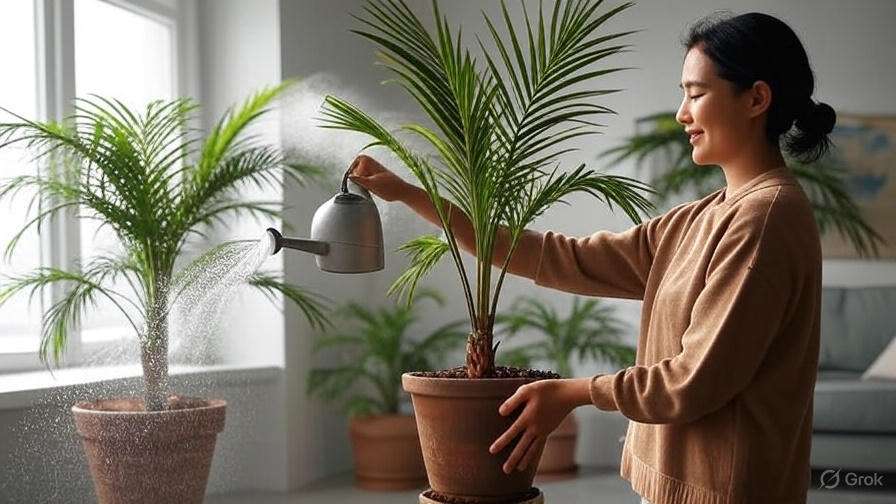
How to Pot and Plant Your Palm Tree 
Planting a palm tree in your garden can bring a tropical flair to any outdoor space, but getting the process right is essential to ensure healthy growth. Here’s a step-by-step guide on how to pot and plant your palm tree with confidence!
Step 1: Choose the Right Pot or Planting Location 
First things first: ensure your palm tree has enough space to grow. If you’re potting it, choose a pot that’s at least 2-3 inches larger in diameter than the root ball. Ensure the pot has drainage holes to prevent waterlogging, which can lead to root rot. If you’re planting directly in the garden, select a location that gets plenty of sunlight and offers well-draining soil.
Step 2: Prepare the Soil 
Palms love light, well-draining soil. If you’re potting, use a cactus or palm-specific potting mix, or create your own mix by blending regular potting soil with sand and perlite. For garden planting, ensure your soil is loamy and drains well. Adding organic compost can help enrich the soil for better root development.
Step 3: Potting Your Palm Tree 
- Remove the Palm from the Nursery Pot: Gently remove your palm from the nursery pot, being careful not to damage the roots. If it’s tightly packed, tease the roots out a little.
- Place in the New Pot: Set your palm in the center of the new pot or hole, ensuring that the top of the root ball is level with the surrounding soil.
- Fill with Soil: Carefully fill the pot with your prepared soil mix, pressing it gently around the root ball. Don’t bury the palm too deep; the crown of the plant (where the roots meet the trunk) should remain slightly above the soil level.
- Water Thoroughly: Give your palm tree a good drink of water right after planting to settle the soil around the roots.
Step 4: Planting Directly in the Garden 
- Dig a Hole: If planting in the ground, dig a hole that’s twice as wide and deep as the root ball of your palm.
- Position Your Palm: Place the root ball into the hole, ensuring it’s level with the surrounding soil.
- Backfill and Water: Fill the hole with soil, tamping it down lightly as you go. Water thoroughly to help settle the soil.
Step 5: Care After Planting 
Once your palm is potted or planted, provide it with the right care to thrive:
- Sunlight: Palms love sunlight, but some varieties prefer partial shade. Make sure you place your palm in the appropriate light conditions.
- Watering: Water your palm deeply but infrequently. Allow the soil to dry out between waterings to prevent root rot.
- Fertilizing: Palm trees benefit from regular feeding. Use a slow-release, palm-specific fertilizer during the growing season (spring to summer).
By following these simple steps, your palm tree will be well on its way to becoming a stunning focal point in your garden. 
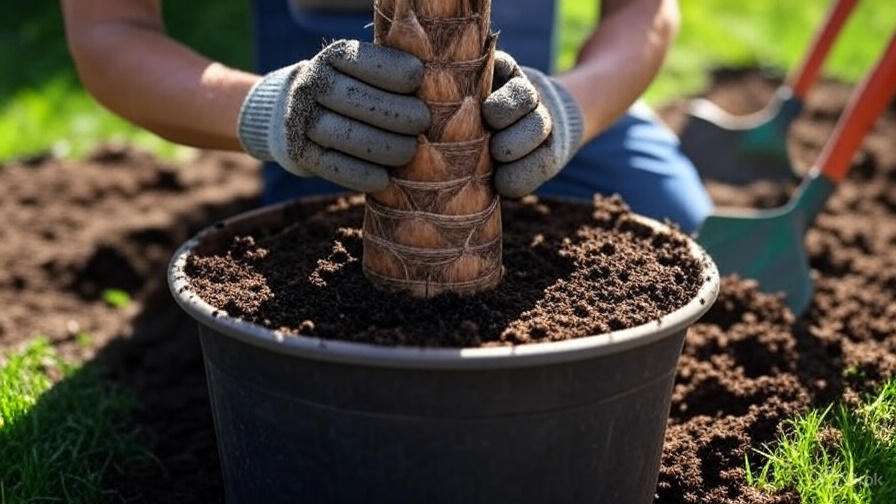
Essential Care Tips for Healthy Potted Palm Trees 
Potted palm trees can add a touch of tropical elegance to any space, but they do require specific care to thrive indoors. With the right attention, your palm can flourish and become a statement piece in your home or garden. Here are the essential care tips to keep your potted palm tree healthy and vibrant.
1. Choosing the Right Pot and Soil 
A good start is half the battle! Choose a pot that is one size larger than the root ball of your palm, with drainage holes to prevent waterlogging. Use well-draining potting soil, preferably a mix designed for palms or cacti. This ensures that the roots receive enough air and don’t sit in water, which can lead to root rot.
2. Optimal Light Exposure 
Palms need plenty of bright, indirect light to grow strong and healthy. Place your potted palm near a window with filtered sunlight, but avoid direct sun, which can scorch the leaves. If natural light is limited, consider using grow lights to give your palm the boost it needs.
3. Watering Wisely 
Overwatering is one of the most common mistakes with potted palms. Let the top 1-2 inches of soil dry out between waterings. When you water, do so thoroughly, ensuring that excess water drains out of the pot. A good rule of thumb: water when the soil feels slightly dry to the touch but never let it dry out completely.
4. Humidity is Key 
Many palms, especially tropical varieties, thrive in humid environments. If you live in a dry area, increase humidity around your palm by misting it occasionally or placing a humidifier nearby. Alternatively, you can place a shallow tray of water with pebbles beneath the pot to help maintain moisture in the air.
5. Fertilizing for Growth 
Feed your palm during the growing season (spring and summer) with a balanced, slow-release fertilizer. Look for one specifically formulated for palms, as they have unique nutrient needs. In the fall and winter, reduce or stop fertilizing, as palms generally need less food during their dormant period.
6. Pruning and Cleaning 
Trim off dead or yellowing fronds to keep your palm looking neat and encourage new growth. Regularly clean the leaves with a damp cloth to remove dust, which can block sunlight and stunt growth. Be gentle when cleaning to avoid damaging the delicate fronds.
7. Repotting When Necessary 
Every couple of years, you may need to repot your palm to provide more space for growth. This is particularly important if you notice the roots becoming crowded or the plant’s growth slowing down. When repotting, make sure to check the roots for any signs of rot or disease.
By following these essential care tips, your potted palm tree will thrive, becoming a beautiful and low-maintenance addition to your home. 
Need more tips on outdoor palm care? Check out our full guide to mastering palm care and growing your garden!
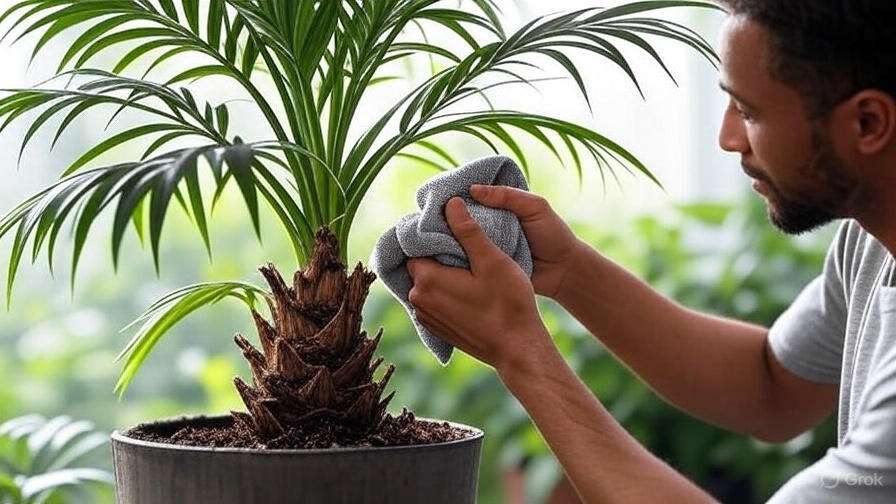
Common Issues and How to Fix Them 
When it comes to growing outdoor palm trees, you might face some challenges. Don’t worry—most of these issues are easily fixable with a bit of attention. Here’s a rundown of common problems and how to solve them:
1. Yellowing Leaves 
Yellow leaves are a sign that something’s off. Common causes include nutrient deficiencies (especially nitrogen), overwatering, or poor soil drainage.
How to fix it:
- Check watering: Make sure you’re not overwatering. Palms prefer their soil to dry out slightly between waterings.
- Fertilize: Apply a balanced, slow-release fertilizer to provide the necessary nutrients.
- Improve drainage: Ensure your palm is planted in well-draining soil to prevent root rot.
2. Brown Tips on Leaves 
Brown tips are often caused by too much fertilizer, low humidity, or inconsistent watering.
How to fix it:
- Reduce fertilizer: If you’ve been overfeeding your palm, scale back on fertilizer to avoid burning the roots.
- Increase humidity: Palms thrive in humid environments. Consider misting the leaves or using a humidifier.
- Water properly: Water your palm evenly, avoiding the roots sitting in water.
3. Pest Infestation 
Palms can attract pests like spider mites, scale, and mealybugs, which can cause leaves to curl or turn yellow.
How to fix it:
- Inspect regularly: Check your palm for pests, especially under the leaves.
- Use insecticidal soap: If pests are present, spray the leaves with insecticidal soap or neem oil to eliminate them.
- Prune affected areas: Trim off any damaged leaves to prevent the pests from spreading.
4. Stunted Growth 
If your palm tree isn’t growing as expected, it could be due to poor soil quality, inadequate sunlight, or overcrowding.
How to fix it:
- Provide sunlight: Ensure your palm is getting the right amount of light. Most palms prefer bright, indirect sunlight.
- Repot if necessary: If the palm is outgrowing its pot, repot it into a larger container with fresh, well-draining soil.
- Give space: Make sure your palm isn’t overcrowded by other plants that could be blocking its access to light and nutrients.
5. Root Rot 
Root rot is one of the most serious issues and is usually caused by overwatering or poor drainage.
How to fix it:
- Check drainage: Ensure your palm’s pot has drainage holes. If planted in the ground, make sure the soil is well-draining.
- Prune affected roots: If you suspect root rot, carefully remove the palm from its pot and prune off any rotting roots. Replant in fresh soil.
- Adjust watering: Allow the soil to dry out before watering again, and avoid letting the roots sit in water.
6. Leaning or Tilting 
Sometimes, palm trees can start leaning or tilting, which can make them unstable.
How to fix it:
- Stabilize with support: Stake the palm to give it the necessary support while it grows. Use a soft tie to avoid damaging the trunk.
- Replant if necessary: If the palm is tilted because of poor planting, gently dig it up and reposition it in a straight position, then refill the hole with soil.
By staying proactive and addressing these common issues quickly, your palm tree will thrive in your garden, adding that tropical flair you’re aiming for!

Conclusion
Potted palm trees are a beautiful and easy way to bring a touch of nature and tropical elegance into your home. With the right palm variety, care routine, and attention to their needs, you can enjoy vibrant greenery and air-purifying benefits all year round. Whether you’re a beginner or an experienced plant parent, following the tips in this guide will help your potted palms thrive in your indoor space.

Now that you know how to choose, grow, and care for your potted palm trees, it’s time to start your journey! Select the perfect palm for your home, provide the right care, and watch as your indoor oasis flourishes. Happy gardening!
Frequently Asked Questions(FAQ)
How often should I water my potted palm tree?
Water your potted palm tree when the top inch of soil feels dry. It’s important not to overwater, as this can lead to root rot. Be sure to use a pot with proper drainage to prevent water from sitting at the bottom.
Can potted palm trees grow in low light conditions?
Yes, some potted palm trees like the Parlor Palm and Bamboo Palm can thrive in low light environments. However, most palms prefer bright, indirect light. Place them near windows where they can get some light but avoid direct sunlight to prevent leaf burn
How do I know when it's time to repot my potted palm tree?
Repot your potted palm tree when the roots start growing out of the drainage holes or when the plant shows slow growth despite proper care. This typically happens every 1-2 years, depending on the size and growth rate of your palm.
What is the ideal temperature for indoor palm trees?
Potted palm trees thrive in temperatures between 65-75°F (18-24°C). They should be kept away from drafts, air conditioners, and heaters, as extreme temperature fluctuations can stress the plant.
How do I prevent pests on my potted palm tree?
To prevent pests like spider mites and mealybugs, regularly inspect your palm for signs of infestation. Use insecticidal soap or neem oil to treat any pests you find. Keep the humidity high and ensure proper watering to help your palm stay healthy and less susceptible to bugs.
Can I keep my potted palm tree outside during the summer?
Yes, you can move your potted palm tree outside during the summer, as long as the temperatures are warm and the plant is not exposed to direct sunlight for long periods. Gradually acclimate the palm to outdoor conditions to avoid shock and ensure it gets some shade during the hottest part of the day.
Why are the leaves of my potted palm tree turning yellow?
Yellowing leaves on a potted palm can be caused by overwatering, underwatering, or a nutrient deficiency. Check the soil moisture and adjust your watering habits accordingly. You may also need to fertilize your palm with a palm-specific fertilizer to correct any nutrient imbalances.
What is the best fertilizer for potted palm trees?
Use a balanced, slow-release fertilizer formulated for palms. Fertilize your palm tree every 4-6 weeks during the growing season (spring and summer). Avoid fertilizing in the winter when the plant is not actively growing, as this can lead to fertilizer burn.


